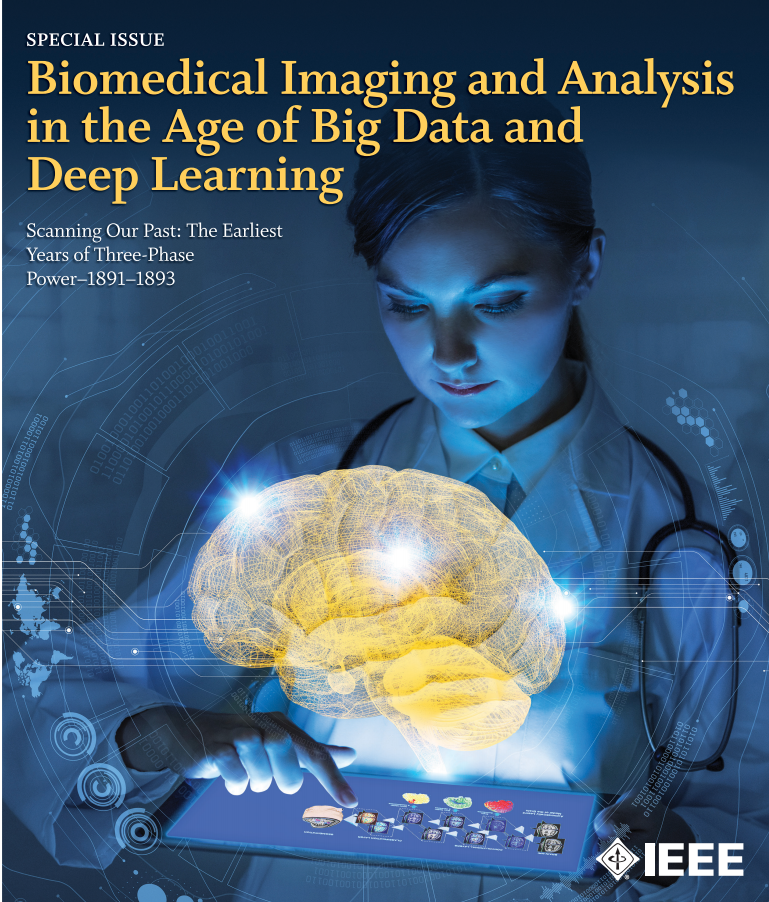- Our Story
- Publications & Resources
- Publications & Resources
- Publications
- IEEE Signal Processing Magazine
- IEEE Journal of Selected Topics in Signal Processing
- IEEE Signal Processing Letters
- IEEE Transactions on Computational Imaging
- IEEE Transactions on Image Processing
- IEEE Transactions on Information Forensics and Security
- IEEE Transactions on Multimedia
- IEEE Transactions on Signal and Information Processing over Networks
- IEEE Transactions on Signal Processing
- IEEE TCI
- IEEE TSIPN
- Data & Challenges
- Submit Manuscript
- Guidelines
- Information for Authors
- Special Issue Deadlines
- Overview Articles
- Top Accessed Articles
- SPS Newsletter
- SigPort
- SPS Resource Center
- Publications FAQ
- Blog
- News
- Dataset Papers
- Conferences & Events
- Community & Involvement
- Professional Development
- For Volunteers
- Information for Authors-OJSP
-
Home
Conferences Events IEEE Signal Processing Magazine IEEE SPL Article IEEE TIFS Article IEEE TMM Article IEEE TSP Article Jobs in Signal Processing Lectures Machine Learning Seasonal Schools Signal Processing News SPM Article SPS Distinguished Lectures SPS Newsletter Article SPS Webinar SPS Webinars SPS Webinar Series Webinar webinars
-
Our Story
What is Signal Processing?

The technology we use, and even rely on, in our everyday lives –computers, radios, video, cell phones – is enabled by signal processing. Learn More » -
Publications & Resources
-
SPS Resources
- Signal Processing Magazine The premier publication of the society.
- SPS Newsletter Monthly updates in Signal Processing
- SPS Resource Center Online library of tutorials, lectures, and presentations.
- SigPort Online repository for reports, papers, and more.
- SPS Feed The latest news, events, and more from the world of Signal Processing.
-
SPS Resources
-
Conferences & Events
-
Community & Involvement
-
Membership
- Join SPS The IEEE Signal Processing Magazine, Conference, Discounts, Awards, Collaborations, and more!
- Chapter Locator Find your local chapter and connect with fellow industry professionals, academics and students
- Women in Signal Processing Networking and engagement opportunities for women across signal processing disciplines
- Students Scholarships, conference discounts, travel grants, SP Cup, VIP Cup, 5-MICC
- Young Professionals Career development opportunities, networking
- Get Involved
-
Technical Committees
- Applied Signal Processing Systems
- Audio and Acoustic Signal Processing
- Bio Imaging and Signal Processing
- Computational Imaging
- Image Video and Multidimensional Signal Processing
- Information Forensics and Security
- Machine Learning for Signal Processing
- Multimedia Signal Processing
- Sensor Array and Multichannel
- Signal Processing for Communication and Networking
- Signal Processing Theory and Methods
- Speech and Language Processing
- Technical Working Groups
- More TC Resources
-
Membership
-
Professional Development
-
Professional Development
- Signal Processing Mentorship Academy (SigMA) Program
- Micro Mentoring Experience Program (MiME)
- Distinguished Lecturer Program
- Distinguished Lecturers
- Distinguished Lecturer Nominations
- Past Lecturers
- Distinguished Industry Speaker Program
- Distinguished Industry Speakers
- Distinguished Industry Speaker Nominations
- Industry Resources
- IEEE Training Materials
- Jobs in Signal Processing: IEEE Job Site
-
Career Resources
- SPS Education Program Educational content in signal processing and related fields.
- Distinguished Lecturer Program Chapters have access to educators and authors in the fields of Signal Processing
- Job Opportunities Signal Processing and Technical Committee specific job opportunities
- Job Submission Form Employers may submit opportunities in the area of Signal Processing.
-
Professional Development
-
For Volunteers
-
For Board & Committee Members
- Board Agenda/Minutes* Agendas, minutes and supporting documentation for Board and Committee Members
- SPS Directory* Directory of volunteers, society and division directory for Board and Committee Members.
- Membership Development Reports* Insight into the Society’s month-over-month and year-over-year growths and declines for Board and Committee Members
-
For Board & Committee Members
Popular Pages
Today's:
- Information for Authors
- IEEE Transactions on Image Processing
- IEEE Transactions on Multimedia
- (SPAWC 2025) 2025 IEEE Workshop on Signal Processing and Artificial Intelligence for Wireless Communications
- IEEE Signal Processing Letters
- IEEE Transactions on Information Forensics and Security
- Information for Authors-SPL
- Submit a Manuscript
- IEEE Journal of Selected Topics in Signal Processing
- IEEE Transactions on Audio, Speech and Language Processing
- (ASRU 2025) 2025 IEEE Automatic Speech Recognition and Understanding Workshop
- Publications & Resources
- IEEE Transactions on Signal Processing
- Unified EDICS
- Editorial Board Nominations
All time:
- Information for Authors
- Submit a Manuscript
- IEEE Transactions on Image Processing
- IEEE Transactions on Information Forensics and Security
- IEEE Transactions on Multimedia
- IEEE Transactions on Audio, Speech and Language Processing
- IEEE Signal Processing Letters
- IEEE Transactions on Signal Processing
- Conferences & Events
- IEEE Journal of Selected Topics in Signal Processing
- Information for Authors-SPL
- Conference Call for Papers
- Signal Processing 101
- IEEE Signal Processing Magazine
- Guidelines
Last viewed:
- IEEE Transactions on Computational Imaging
- IEEE Transactions on Audio, Speech and Language Processing
- Conference Call for Papers
- Editorial Board Nominations
- Editorial Board
- Call For Proposals: IEEE ICIP 2026
- (ICIP 2026) 2026 IEEE International Conference on Image Processing
- SPS Scholarship Program
- Information for Authors
- (SPAWC 2025) 2025 IEEE Workshop on Signal Processing and Artificial Intelligence for Wireless Communications
- Predict-and-Update Network: Audio-Visual Speech Recognition Inspired by Human Speech Perception
- Adaptive Multimodal Graph Integration Network for Multimodal Sentiment Analysis
- Guidelines for Reviewers
- Dataset Papers
- IEEE Signal Processing Letters
What Should We Learn? Biomedical Imaging and Analysis in the Age of Big Data and Deep Learning
You are here
Newsletter Menu
Newsletter Categories
Top Reasons to Join SPS Today!
1. IEEE Signal Processing Magazine
2. Signal Processing Digital Library*
3. Inside Signal Processing Newsletter
4. SPS Resource Center
5. Career advancement & recognition
6. Discounts on conferences and publications
7. Professional networking
8. Communities for students, young professionals, and women
9. Volunteer opportunities
10. Coming soon! PDH/CEU credits
Click here to learn more.
News and Resources for Members of the IEEE Signal Processing Society
What Should We Learn? Biomedical Imaging and Analysis in the Age of Big Data and Deep Learning

Imaging of the human body using a number of different modalities has revolutionized the field of medicine over the past several decades and continues to grow at a rapid pace. More than ever, previously unknown information about biology and disease is being unveiled at a range of spatiotemporal scales. Although results and clinical adoption of strategies related to the computational and quantitative analysis of the images have lagged behind development of image acquisition approaches, there has been a noticeable increase of effort and interest in these areas in recent years. This special issue of PROCEEDINGS OF THE IEEE, January 2020, aims to define and highlight some of the “hot” newer ideas that are in biomedical imaging and analysis, intending to shine a light on where the field might move in the next several decades, and focuses on emphasizing where electrical engineers have been involved and could potentially have the most impact.
These areas include image acquisition physics, I mage/signal processing, and image analysis, including pattern recognition and machine learning. This issue focuses on two themes common in much of this effort: first, engineers and computer scientists have found that the information contained in medical images, when viewed through image-based vector spaces, is generally quite sparse. This observation has been transformative in many ways and is quite pervasive in the articles included here. Second, medical imaging is one of the largest producers of “big data,” and data-driven machine-learning techniques (e.g., deep learning) are gaining significant attention because of improved performance over previous approaches. Thus, data-driven techniques, e.g., formation via image reconstruction and image analysis via deep learning, are gaining momentum in their development.
The set of articles included examine the capability of image science to explore the complexity of life systems, from bacterial colonies to human medicine. This goal has challenged biological and medical imaging researchers to develop sensing techniques capable of tracking cellular communications over a large range of spatiotemporal scales to explore the hierarchy of properties emerging from complex living systems.
The search for deeper understanding and clearer diagnostic assessments is driving technology into higher dimensional spaces. Ideas that began with multimodality approaches for imaging and treating cancer and cardiovascular disease have expanded into developing techniques that reveal the systemic role of the microbiome in healthy cells and disease cells, the topology of brain connectivity and biochemistry in cognition, and cognitive computing in image formation and interpretation where human pattern recognition and model-based image formation methods are hitting their limits. The limitations encountered when modeling instruments as linear systems can be overcome using data-driven approaches now offered through a range of machine learning techniques. Yet many sense that the most useful and robust models may involve some mixture of model-based and data-driven approaches. The articles that are included focus on a collection of topics, which are important areas for the future of biomedical imaging.
Open Calls
Publications News
Society News
- OU Analytics - Tip of the Month
- Sections Congress 2020: New Opportunities to Learn and Network
- 2019 Financial and Officer Reporting Dates
- Job Opportunities in Signal Processing
- Upcoming Distinguished Lectures
- Hyderabad Chapter selected as the 2019 SPS Chapter of the Year Award recipient
- New SPS Chapters in 2019
Education & Resources
Technical Committee News
Member Highlights
PhD Theses
Conferences & Events
SPS Social Media
- IEEE SPS Facebook Page https://www.facebook.com/ieeeSPS
- IEEE SPS X Page https://x.com/IEEEsps
- IEEE SPS Instagram Page https://www.instagram.com/ieeesps/?hl=en
- IEEE SPS LinkedIn Page https://www.linkedin.com/company/ieeesps/
- IEEE SPS YouTube Channel https://www.youtube.com/ieeeSPS
Home | Sitemap | Contact | Accessibility | Nondiscrimination Policy | IEEE Ethics Reporting | IEEE Privacy Policy | Terms | Feedback
© Copyright 2025 IEEE - All rights reserved. Use of this website signifies your agreement to the IEEE Terms and Conditions.
A public charity, IEEE is the world's largest technical professional organization dedicated to advancing technology for the benefit of humanity.









